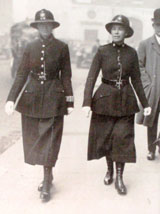Attracting Recruits
Notwithstanding the ugly uniform, a career in the women police was attractive for a number of women. While these officers were not seen to be undertaking 'proper' policing (indeed, women were not integrated into the force on the same terms as men until 1969-73) 'the job' provided a career structure with the prospect of accommodation for young recruits, of promotion, and a pension.
The booklet Conditions of Entry and Terms of Service as Woman Police Officer (1938) succinctly outlines the duties, qualifications and training necessary for those wishing to become police officers. Pages 11 to 14 are particularly interesting as they contain a mock of the examination paper that recruits were required to sit.

The final document It's a Woman's Work (1939) is also revealing particularly for showing what was expected of women police officers. The title page, for example, focuses on Trafalgar Square, a large open space frequented by unemployed people during the inter-war years. The image of the female officer here is expressionless and anonymous, perhaps suggesting the idea that a woman needs to take on the identity of the group in pursuing her job (much like the male officer). The title It's a Woman's Work, however, reassures the potential candidate that the tasks that she faces 'on the job' are feminine. The first page reaffirms the message in the title: '[The work is] mostly concerned with the assistance and protection of women and children'.
 WPC 18 Ellis and Inspector Clayden patrolling outside Bow Street Police Station, 1924.
WPC 18 Ellis and Inspector Clayden patrolling outside Bow Street Police Station, 1924.